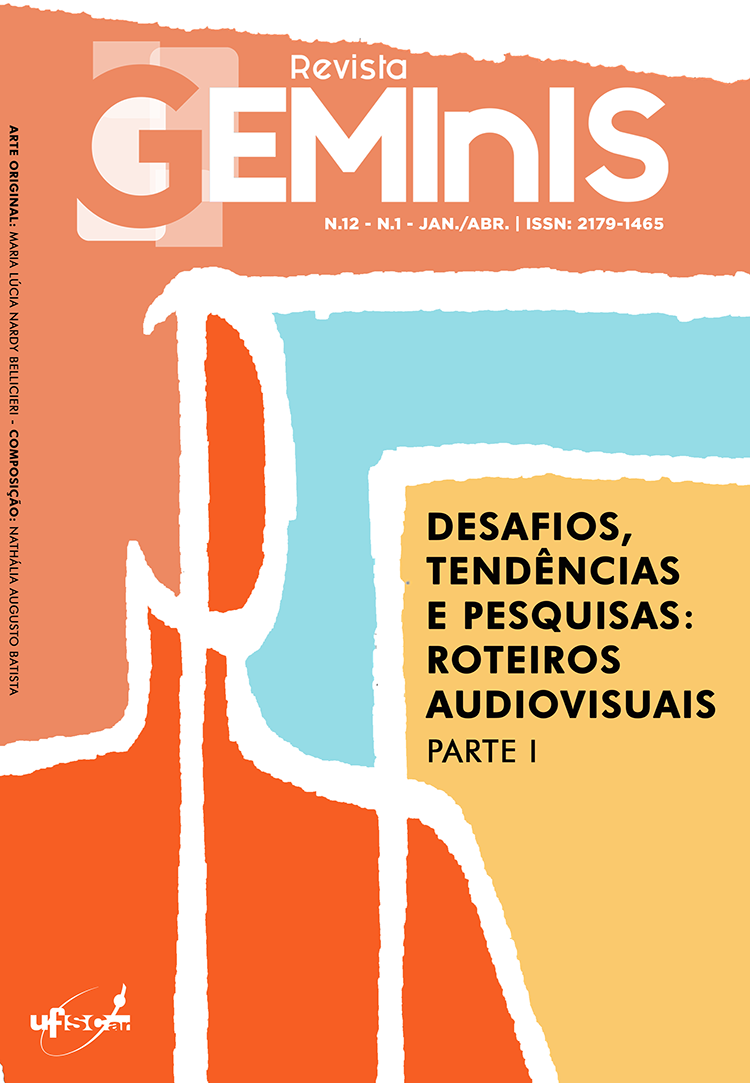CREATIVE PONTENTIAL OF THE WRITER’S ROOM AND THE ROLE OF THE SHOWRUNNER
PRELIMINARY NOTES
DOI:
https://doi.org/10.53450/2179-1465.RG.2021v12i1p25-41Keywords:
writers' room, showrunner, creative environmentsAbstract
The writers' room consists of a work environment in which professionals develop scripts, mainly for series. As creativity is influenced by the work environment, this article seeks to identify which and how the characteristics of a creative environment are placed, such as freedom, challenge and support from the boss, in the dynamics of scriptwriters' rooms. Narrative literature review is used. The role of the leader in this context is discussed and an attempt is made to initiate an investigation with the intention of understanding how the writers 'rooms can be managed in order to become positive influences on the writers' creativity.
Downloads
References
AMABILE, Teresa M. Social psychology of creativity: A consensual assessment technique. Journal of personality and social psychology, v. 43, n. 5, p. 997, 1982.
AMABILE, Teresa M.; GRYSKIEWICZ, Nur D. The creative environment scales: Work environment inventory. Creativity research journal, v. 2, n. 4, p. 231-253, 1989.
AMABILE, Teresa M. Motivating Creativity in Organizations: On Doing What You Love and Loving What You Do. California Management Review, v. 40, n. 1, p. 39–58, 1997.
AMABILE, Teresa M. et al. Leader behaviors and the work environment for creativity: Perceived leader support. The Leadership Quarterly, v. 15, n. 1, p. 5-32, 2004.
ARIETI, Silvano. Creativity: The magic synthesis. 1976.
BLOORE, Peter. The screenplay business: Managing creative and script development in the film industry. New York: Routledge, 2013.
CSIKSZENTMIHALYI, Mihaly. Flow and the psychology of discovery and invention. New York: Harper Collins, 1996.
CSIKSZENTMIHALYI, Mihaly. The systems model of creativity: The collected works of Mihaly Csikszentmihalyi. Springer, 2015.
DE FARIA, Maria de Fátima Bruno; ALENCAR, Eunice ML Soriano de. Estímulos e barreiras à criatividade no ambiente de trabalho. Revista de Administração da Universidade de São Paulo, v. 31, n. 2, 1996.
GRAHAM, J. AND GANDINI, A. Introduction: Collaborative Production in the Creative Industries. In: Graham, J. and Gandini, A. (eds.). Collaborative Production in the Creative Industries. Pp. 1–14. London: University of Westminster Press, 2017. Disponível em: https://www.uwestminsterpress.co.uk/site/books/10.16997/book4/. Acesso em: 20 jan. 2019.
GREFFE, X. A Economia Artisticamente Criativa. Tradução Ana Goldberger. São Paulo: Iluminuras e Itaú Cultural, 2015.
HADAS, L. From the Workshop of J. J. Abrams: Bad Robot, Networked Collaboration, and Promotional Authorship. In: Graham, J. and Gandini, A. (eds.). Collaborative Production in the Creative Industries. Pp. 87–103. London: University of Westminster Press, 2017.
HENNESSEY, Beth A.; AMABILE, Teresa M. Creativity. Annual Review of Psychology, v. 61, n. 1, p. 569–598, 2010.
JENKINS, Henry. Cultura da convergência. Aleph, 2015.
JENNER, Mareike. Is this TVIV? On Netflix, TVIII and binge-watching. New Media & Society, v. 18, n. 2, p. 257–273, 2016. Disponível em: <https://doi.org/10.1177/1461444814541523>. Acesso em: 31 ago. 2019.
JONES, Candace; LORENZEN, Mark; SAPSED, Jonathan (orgs). The Oxford Handbook of Creative Industries. Oxford University Press, United Kingdom, 2015.
KALLAS, Christina. Na sala de roteiristas: Conversando com os autores de Friends, Família Soprano, Mad Men, Game of Thrones e outras séries que mudaram a TV. Rio de Janeiro: Zahar, 2016.
MARTIN, Brett. Homens Difíceis: os bastidores do processo criativo de Breaking Bad, Família Soprano, Mad Men e outras séries revolucionárias. São Paulo: Alphe, 2014.
MASSAROLO, J., MESQUITA, D. Práticas de binge-watching nas multiplataformas. 2016. Disponível em: https://www.researchgate.net/profile/Joao_Massarolo/publication/328491910_Praticas_de_binge-watching_nas_multiplataformas/links/5bd0ff95a6fdcc6f7900379f/Praticas-de-binge-watching-nas-multiplataformas.pdf. Acessado em: 02 fev. 2019.
MITTELL, J. Notes on Rewatching. 2011. Disponível em: https://justtv.wordpress.com/2011/01/27/notes-on-rewatching/. Acesso em: 31 ago. 2019.
MITTELL, Jason. Complex TV: The Poetics of Contemporary Television Storytelling. New York: New York University Press. 2015.
MITTELL, Jason. Complexidade narrativa na televisão americana contemporânea. MATRIZes, v. 5, n. 2, p. 29-52, 2012.
MUZZIO, Henrique. Indivíduo, liderança e cultura: Evidências de uma gestão da criatividade. Revista de Administração Contemporânea, v. 21, n. 1, p. 107-124, 2017.
NEWMAN, Michael Z., LEVINE, Elana. Legitimating Television: Media Convergence and Cultural Status. London: Routledge, 2012, 232 p.
OAKLEY, Kate. Good work? Rethinking cultural entrepreneurship. In: Handbook of management and creativity. Edward Elgar Publishing, 2013.
OSTROWER, Fayga. Criatividade e processos de criação. Petrópolis: Editora Vozes, 1978.
RUSSELL, Cristel Antonia; STERN, Barbara B.; STERN, Barbara B. Consumers, characters, and products: A balance model of sitcom product placement effects. Journal of Advertising, v. 35, n. 1, p. 7-21, 2006.
SCHWARTZ, J. O momento criativo: Mito e alienação na ciência moderna. São Paulo: Best Seller: 1992.
STEIN, Morris I. Stimulating creativity: Individual procedures. Academic Press, 2014.
STERNBERG, Robert J.; LUBART, Todd I. The concept of creativity: Prospects and paradigms. Handbook of creativity, v. 1, p. 3-15, 1999.
UNCTAD. Creative economy report 2010. Ginebra: UNCTAD, 2010.
Downloads
Published
How to Cite
Issue
Section
License
Authors who publish in this journal agree to the following terms:
a. Authors retain copyright and grant the journal the right of first publication, with the work simultaneously licensed under a Creative Commons Attribution License that allows sharing of the work with acknowledgment of authorship and initial publication in this journal.
b. Authors are authorized to assume additional contracts separately, for non-exclusive distribution of the version of the work published in this journal (eg, to publish in an institutional repository or as a book chapter), with acknowledgment of authorship and initial publication in this journal.


